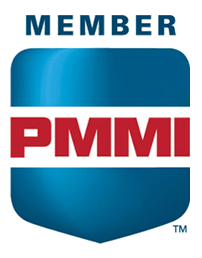Custom Machines
Pneumatic Denesting: Morrison's container handling expertise was applied to this mechanical/pneumatic controlled denesting custom drive assembly. Designed to accept an operator feed of stacks of cups, separate, index and feed one cup into each bucket, a pneumatic brake controls the feed and a mechanical/pneumatic escapement releases one cup into a bucket. Photoeye/timer is used to send the bucket location and provide feedback to the pneumatics, providing one perfectly executed scoop drop per bucket, each time.
Quick Change Over - Rotary Machine Stars/Guides: This video shows Morrison’s standard tool-less change over parts on a rotary filling machine. The video walks through taking off all parts on the machine. While the video has been edited, it still demonstrates how change-over can be accomplished in a very short amount of time.
3 Up Indexing Denester: In this application, Morrison is accepting containers from a stack/nest. This type of denesting process is typically seen on a holmatic style machine where the containers are dropped into buckets that index as they travel through the filling and capping process. The system highlighted in this video has longer timing screws than what is typically seen on a holmatic machine. Having longer screws allows the containers to create more separation and Morrison can eliminate the suction/vacuum that containers have when they are nested.
Down Bottle Reject: There are many times that companies deal with inefficiencies and down time due to containers falling over on the production line. Instead of having a person standing on the line looking for a down container, it is much more cost effective and efficient to implement a down bottle reject to kick off any containers that have already fallen down. Depending on the shape and the application, Morrison can provide a variety of solutions. Morrison can provide a pneumatically powered system that will knock off all down containers as they pass by, as well as a mechanical system that solely relies on rail setup. By utilizing the geometry of the containers and position of the rails in relationship to the conveyor, Morrison can slide down containers off the side of the conveyor while still allowing all of the upright containers to continue down the line
Rotary Topper: This system is designed to be implemented into a production line just before some type of capping machine. It can be implemented before a seamer, capper, overcapper, etc. The system is designed to create enough head space to make sure the capping process can occur. In some of the videos you are seeing that the system is displacing liquid, which allows for enough head space in a seaming machine. This is important to make sure containers don’t explode from pressure after the seaming process. In other shots, you will see a system that was designed for compressing pickles into the container to make sure the pickles were properly packed and into the container deep enough for the capping process to occur.
Can Opener and Crusher: This is an application that most people/companies will not think of Morrison unless they have seen the machine first hand. There are many end users that need to purchase their bulk product in #10 cans. Product like tomato paste, mushrooms, beats, tomatoes, peaches, etc. are all initially packaged in #10 cans to create a longer shelf life. Companies like Del Monte Foods, Seneca Foods, HJ Heinz, etc. need to open these cans to reuse/repackage the product. Morrison has been building can openers since the mid-80s and can open cans at 60 cpm. The containers are initially controlled with a timing screw and pass underneath a plunger/knife. The timing screw has a dwell designed in it to hold the can in a single position for a short amount of time. The timing screw continues to spin, but the vertical thread form/pocket keeps the container in a consistent position. While the container is in the dwell, the plunger/knife comes down and punches a hole around the lid of the can. Once the hole has been punched, a magnetic hand comes down and pulls off the lid. The lid is then dropped into a chute to be sent to the garbage/recycling.
Once the cans have been opened, they are then pushed through a stainless steel twist simply by back pressure. The cans are twisted to be upside down so that the product can be dumped out into a collection bin. Morrison sells (and recommends) a magnetic grate to be directly above the collection bin to detect and remove loose metal shavings created by the plunger/knife. While the containers are upside down, you may notice the rails vibrating. This vibration is to help remove the entire product from the cans, as the viscosity in products can vary quite a lot. Once product is removed, companies want to minimize the footprint that the empty #10 cans take up. Morrison offers a pneumatic can crusher to shrink the footprint that the empty cans create.












